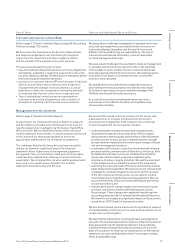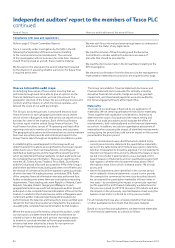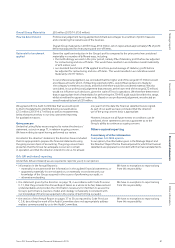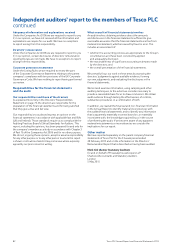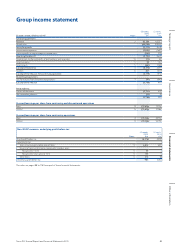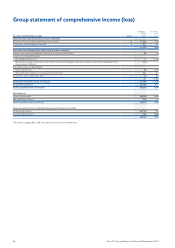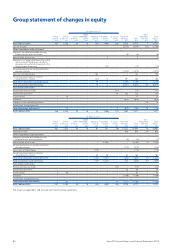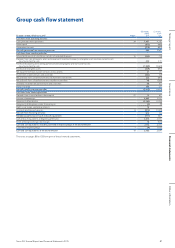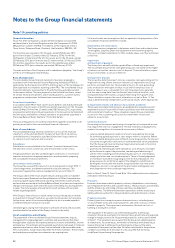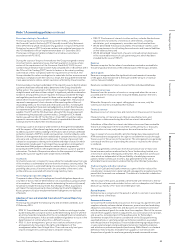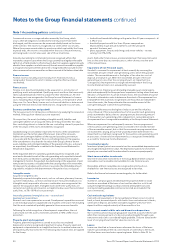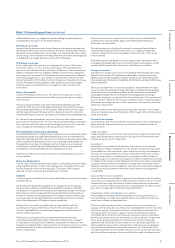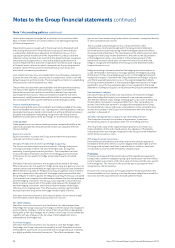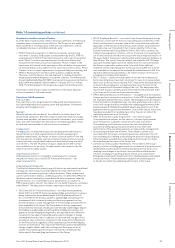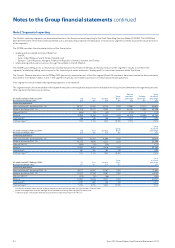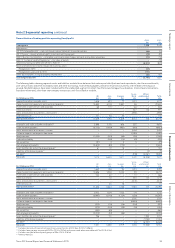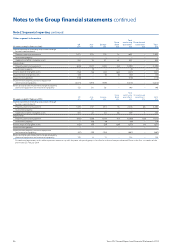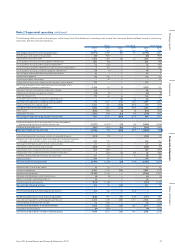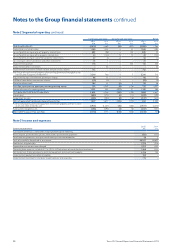Tesco 2015 Annual Report Download - page 90
Download and view the complete annual report
Please find page 90 of the 2015 Tesco annual report below. You can navigate through the pages in the report by either clicking on the pages listed below, or by using the keyword search tool below to find specific information within the annual report.
Critical estimates and assumptions that are applied in the preparation ofthe
consolidated financial statements include:
Depreciation and amortisation
The Group exercises judgement to determine useful lives and residual values
of intangibles, property, plant and equipment and investment property.
The assets are depreciated down to their residual values over their estimated
useful lives.
Impairment
a) Impairment of goodwill
The Group tests annually whether goodwill has suffered any impairment.
The recoverable amount of the cash-generating units are based on the higher
of value in use and fair value less cost of disposal. These calculations require
the use of estimates as set out in Note 10.
b) Impairment of assets
The Group has determined each store as a separate cash-generating unit for
impairment testing. Where there are indicators of impairment, the Group
performs an impairment test. Recoverable amounts for cash-generating
units are based on the higher ofvalue in use and fair value less costs of
disposal. Value in use is calculated from cash flow projections generally
over five years using data from the Group’s latestinternal forecasts, and
extrapolated beyond five years using estimated long-term growth rates.
These calculations require the use of estimates asset out in Note 11. Fair
value is determined by independent, professional valuers where appropriate.
c) Impairment of loans and advances to customers and banks
The Group’s loan impairment provisions are established to recognise incurred
impairment losses in its portfolio of loans classified as loans and receivables
and carried at amortised cost. These calculations require the use of estimates
as set out in the accounting policy note for impairment of loans and
advances to customers.
Commercial income
Accounting for the amount and timing of recognition of commercial income
may require the exercise of judgement. The key estimates and judgements
made in the recognition of commercial income are as follows:
• volume-related allowances relate to amounts receivable by the Group
for achieving agreed purchase or sales targets within a set period. Where
volume-related allowances span different accounting periods, the amount
of income recognised in each period is estimated based on the probability
that the Group will meet contractual target volumes based on historical
and forecast performance; and
• promotional, marketing and other allowances cover amounts receivable
by the Group to support the promotion, marketing and advertising of
specific items including promotional pricing discounts, in-store displays,
margin protection and cost reimbursements. There is limited judgement
or estimation involved in recognising income for these allowances. The
group assesses its performance against the obligations conditional on
earning the income, with the income recognised either over time as the
obligations are met, or recognised at the point when all obligations are
met, dependent on the contractual requirements.
Refer to Note 3, Note 15, Note 16 and Note 19 for additional income statement
and balance sheet disclosure.
Provisions
Provisions have been made for property contracts, dilapidations, restructuring,
post-employment benefits and customer redress. These provisions are estimates
and the actual costs and timing of future cash flows are dependent
on future events. The difference between expectations and the actual future
liability will be accounted for in the period when such determination is made.
Property provisions
Property provisions comprise onerous lease provisions, including leases
on unprofitable stores and vacant properties, and other onerous contracts
related to property. These provisions are based on the least net cost of
fulfilling or exiting the contract.
The calculation of the value in use of the leased property to the Group
is based on the same assumptions for discount rates, growth rates and expected
change in margins as those for Group owned properties, as discussed in detail
in Note 11. The calculations also assume that the Group can sublet properties
at market rents. For some leases, termination of the lease at the break clause
requires the Group to either purchase the property or buy out the equity
ownership of the property at fair value. No value is attributed to the purchase
conditions since they are at fair value. It is also assumed that the Group
is indifferent to purchasing the properties.
Note 1 Accounting policies
General information
Tesco PLC (‘the Company’) is a public limited company incorporated
anddomiciled in the United Kingdom under the Companies Act 2006
(Registration number 445790). The address of the registered office is
Tesco House, Delamare Road, Cheshunt, Hertfordshire, EN8 9SL, UK.
The financial year represents the 53 weeks ended 28 February 2015
(prior financial year 52 weeks ended 22 February 2014). For the UK,
the Republic of Ireland and the US, the results are for the 53 weeks ended
28 February 2015 (prior financial year 52 weeks ended 22 February 2014).
For all other operations, the results are for the calendar year ended
28 February 2015 (prior calendar year ended 28 February 2014).
The main activities of the Company and its subsidiaries (together, ‘the Group’)
are those of retailing and retail banking.
Basis of preparation
The consolidated Group financial statements have been prepared in
accordance with International Financial Reporting Standards (‘IFRS’) as
endorsed by the European Union (‘EU’), and those parts of the Companies Act
2006 applicable to companies reporting under IFRS. The consolidated Group
financial statements are presented in Pounds Sterling, generally rounded
to the nearest million. They are prepared on the historical cost basis, except
for certain financial instruments, share-based payments, customer loyalty
programmes and pensions that have been measured at fair value.
Discontinued operations
In accordance with IFRS 5 ‘Non-current assets held for sale and discontinued
operations’, the net results of the Chinese and US operations for the 13 weeks
ended 28 May 2014 and the 53 weeks ended 28 February 2015, respectively,
are presented within discontinued operations in the Group Income Statement
and the assets and liabilities of these operations are presented separately in
the Group Balance Sheet. See Note 7 for further details.
The accounting policies set out below have been applied consistently to all
periods presented in these consolidated financial statements.
Basis of consolidation
The consolidated Group financial statements consist of the financial
statements of the ultimate Parent Company (‘Tesco PLC’), all entities
controlled by the Company (its subsidiaries) and the Group’s share of
its interests in joint ventures and associates.
Subsidiaries
Subsidiaries are consolidated in the Group’s financial statements from
the date that control commences until the date that control ceases.
Intragroup balances and any unrealised gains and losses or income and
expenses arising from intragroup transactions are eliminated in preparing
the consolidated financial statements.
Joint ventures and associates
The Group has assessed the nature of its joint arrangements under IFRS 11
‘Joint arrangements’ and determined them to be joint ventures. This
assessment required the exercise of judgement as set out in Note 13.
The Group’s share of the results of joint ventures and associates is included in
the Group Income Statement and Group Statement of Other Comprehensive
Income using the equity method of accounting. Investments in joint ventures
and associates are carried in the Group Balance Sheet at cost plus post-acquisition
changes in the Group’s share of the net assets of the entity, less any impairment
in value. The carrying values of investments in joint ventures and associates
include acquired goodwill.
If the Group’s share of losses in a joint venture or associate equals or exceeds
its investment in the joint venture or associate, the Group does not recognise
further losses, unless it has incurred obligations to do so ormade payments
on behalf of the joint venture or associate.
Unrealised gains arising from transactions with joint ventures and associates
are eliminated to the extent of the Group’s interest in the entity.
Use of assumptions and estimates
The preparation of the consolidated Group financial statements requires
management to make judgements, estimates and assumptions that affect
the application of policies and reported amounts of assets and liabilities, income
and expenses. The estimates and associated assumptions are based on historical
experience and various other factors that are believed to be reasonable under
the circumstances. Actual results may differ from these estimates. The estimates
and underlying assumptions are reviewed on an ongoing basis.
88 Tesco PLC Annual Report and Financial Statements 2015
Notes to the Group financial statements



